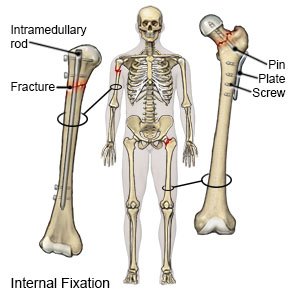ORIF of a Hip Fracture in Children
Medically reviewed by Drugs.com. Last updated on Apr 6, 2025.
What do I need to know about open reduction and internal fixation (ORIF) of a hip fracture?
ORIF of a hip fracture is surgery to fix a broken bone in your child's hip. Open reduction means that the bone is moved back into the right place with surgery. Internal fixation means that hardware (such as screws, rods, or pins) is used to hold the broken bones together. ORIF of a hip fracture is also called percutaneous hip pinning.
 |
How do I prepare my child for ORIF?
- Your child's surgeon will tell you how to prepare. He or she may tell you not to let your child eat or drink anything after midnight before surgery.
- Tell your child's surgeon about all the medicines your child currently takes. He or she will tell you if you need to stop any of your child's medicines for surgery, and when to stop. He or she will tell you which medicines to give your child on the day of surgery.
- Tell your child's healthcare provider about all of your child's allergies. Tell him or her if your child has had an allergic reaction to anesthesia, antibiotics, or contrast liquid.
- Your child may need blood tests, an x-ray, bone scan, MRI, or ultrasound before his or her surgery. These tests may show what kind of fracture your child has so healthcare providers can better plan his or her care. Do not let your child enter the MRI room with anything metal. Metal can cause serious injury. Tell the healthcare provider if your child has any metal in or on his or her body.
What will happen during my child's ORIF?
- Your child will be given general anesthesia to keep him or her asleep during surgery. An incision will be made on your child's hip. Blood that has collected around the fracture may be drained. This will decrease pressure and help blood flow to the bone and the area around it.
- The femur head may be reshaped to help better fit the bone into place. If a disease caused the fracture, bone samples may be taken and sent for tests. The broken bone will be moved back into place and fixed in place with hardware.
What will happen after my child's ORIF?
- Medicine may be given to prevent or treat pain or a bacterial infection.
- Your child may be placed in a hip spica cast. This cast goes around your child's stomach and extends down his or her hip and thigh. Instead of a hip spica cast, your child may have a cast only on the injured leg. Your child may have a bar between his or her legs that is attached to the cast. This bar holds his or her bones and joint in place so they can heal.

- Healthcare providers will work with you and your child so that leg movements will slowly increase over time. Your child may be in a cast for up to 8 weeks. Then he or she may begin physical therapy. Ask healthcare providers if and when your child may need to have his or her hardware removed.
What are the risks of ORIF for a hip fracture?
- Surgery may damage the nerves in your child's leg. The hip may not heal correctly, or it may fracture again. Your child's bones may not grow back together, and he or she may need more surgery. He or she may need surgery to replace his or her hip with artificial parts. Depending on what part of the hip was broken, your child's bones may not grow correctly. Your child may develop a life-threatening blood clot.
- Blood flow to the head of the femur could be poor, and the bone could begin to die. This can cause pain, swelling, trouble moving the hip, and changes to the shape of the femur. Surgery may be needed to treat this condition. Hardware placed during ORIF may move into the joint area, causing problems with bone growth. After ORIF, the angle of your child's hip bones may change, or the growth plate of his or her femur may close early. These changes could cause one of your child's legs to be shorter than the other, and cause trouble walking.
Care Agreement
You have the right to help plan your child's care. Learn about your child's health condition and how it may be treated. Discuss treatment options with your child's healthcare providers to decide what care you want for your child. The above information is an educational aid only. It is not intended as medical advice for individual conditions or treatments. Talk to your doctor, nurse or pharmacist before following any medical regimen to see if it is safe and effective for you.© Copyright Merative 2025 Information is for End User's use only and may not be sold, redistributed or otherwise used for commercial purposes.
Further information
Always consult your healthcare provider to ensure the information displayed on this page applies to your personal circumstances.
